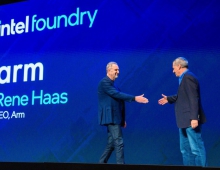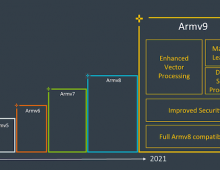
ARM Targets Mid-Range Mobile Devices with New Suite of IP
ARM on Monday announced at Computex an optimized IP
solution - the ARM Cortex-A12 processor, the Mali-T622
GPU, Mali-V500 video solution and POP IP technology -
designed to power mid-range mobile devices smartphones
and tablets.
The mid-range market is projected to exceed the number
of premium smartphones and tablets beginning in 2015.
Targeted at the mid-range market, this new suite of ARM
IP is optimized for power, performance and die size.
Used together, this suite of IP provides features like
virtualization, big.LITTLE processing and GPU compute at
mid-range price points.
The suite extends the ARM Cortex-A processor and ARM Mali-T GPU series with the Cortex-A12 processor and Mali-T622 GPU and introduces a new video IP product, the Mali-V500. With support from ARM POP technology and the ARM Development Studio 5 (DS-5) toolchain, ARM partners can deliver smartphones and tablets with higher efficiency and reduced time to market. ARM expects this IP solution will be in mobile devices by mid-2014.
"Mobile users expect a range of devices at different price points and for a mid-range mobile experience to include some high end mobile features. With a billion smartphones predicted to ship in 2013 and tablets projected to out-ship notebook PCs, device-makers can now provide quality, high-performance mobile products with the features that matter the most, at a range of price points," said Ian Drew, chief marketing officer and executive vice president, ARM. "The market is evolving at an amazing rate and there is now a choice of solutions for semiconductor companies and for mobile device-makers. Our suite of optimized IP expands the choice for the mid-range mobile market."
The energy-saving technology known as ARM big.LITTLE processing is only just coming to high-end devices today, but now can be designed into mid-range smartphones, allowing users to do more with their devices. ARM claims that the Cortex-A12 processor offers a 40 percent performance uplift in the same power envelope when compared to the Cortex-A9 processor. The Cortex-A12 processor builds on efficiency as a standalone solution and additionally supports the big.LITTLE processing technology with the Cortex-A7 processor. The Cortex-A12 also introduces features found in premium smartphones and tablets to mid-range devices, including virtualization.
The Mali-T622 GPU, is OpenGL ES 3.0 conformant, supports the Renderscript and OpenCL APIs, and is the smallest full profile GPU Compute solution available for mobile devices. It is also providing a 50 percent energy-efficiency improvement over first-generation Mali-T600 series products.
The Mali-V500 video solution provides dedicated video processing and reduces system bandwidth requirements by more than 50 percent compared to currently available solutions. The Mali-V500 is a multicore video solution, scaling from a single core capable of 1080p/60 encode and decode to multiple cores supporting ultra-high definition 4K at 120 frames per second. Additionally, the Mali-V500 video solution was architected with support for TrustZone security technology enabling hardware-backed security for movie and TV content from download to display.
ARM DS-5 toolchain to support development and optimization of software for systems based on the Cortex-A12 processor, Mali-T622 GPU, and CoreLink CCI-400 cache coherent interconnect. Complemented by the addition of the ARM Fast Models simulation library, the DS-5 toolchain enables early software development and system-wide performance and power optimization.
POP IP for the Cortex-A12 processor is available now for TSMC 28HPM process technology. It will also be available at GLOBALFOUNDRIES 28-SLP process technology in Q4 2013.
GLOBALFOUNDRIES claims that its 28nm-SLP process technology and associated ARM POP IP for the Cortex-A12 processor enables up to 70 percent higher performance (measured single-thread performance) and up to 2x better power efficiency in comparison to a Cortex-A9 processor using 40nm process technology. GLOBALFOUNDRIES' next-generation 14nm-XM FinFET technology is expected to bring another dimension of enhanced power, performance and area for ARM mobile processors. A Cortex-A9 processor implemented on 14nm-XM technology, using 9-track libraries, is projected to enable a greater than 60 percent increase in frequency at constant power, or a decrease of more than 60 percent in power consumption at constant performance, when compared to implementation on 28nm-SLP technology using 12-track libraries. Similar results are expected for Cortex-A12 processor implementations.
Intel has said it has managed to match ARM on battery life in smartphones and tablets with its current Atom processors, and will take the lead with its upcoming Atom chips based on the new Silvermont architecture.
But ARM executives dismissed that claim during at Computex in Taipei, saying the company's processor designs continue to offer more performance at low power consumption levels, and that it will continue to lead in battery life.
Intel Silvermont's power-saving features are generally attributed to Intel's the 22-nanometer manufacturing process, in which 3D transistors are stacked on top of one another (FinFET).
ARM-based chips do not have 3D transistor stacking features, although ARM is catching up on that, since chip manufacturers GlobalFoundries and TSMC are expected to implement 3D transistors in 2014 or 2015.
The suite extends the ARM Cortex-A processor and ARM Mali-T GPU series with the Cortex-A12 processor and Mali-T622 GPU and introduces a new video IP product, the Mali-V500. With support from ARM POP technology and the ARM Development Studio 5 (DS-5) toolchain, ARM partners can deliver smartphones and tablets with higher efficiency and reduced time to market. ARM expects this IP solution will be in mobile devices by mid-2014.
"Mobile users expect a range of devices at different price points and for a mid-range mobile experience to include some high end mobile features. With a billion smartphones predicted to ship in 2013 and tablets projected to out-ship notebook PCs, device-makers can now provide quality, high-performance mobile products with the features that matter the most, at a range of price points," said Ian Drew, chief marketing officer and executive vice president, ARM. "The market is evolving at an amazing rate and there is now a choice of solutions for semiconductor companies and for mobile device-makers. Our suite of optimized IP expands the choice for the mid-range mobile market."
The energy-saving technology known as ARM big.LITTLE processing is only just coming to high-end devices today, but now can be designed into mid-range smartphones, allowing users to do more with their devices. ARM claims that the Cortex-A12 processor offers a 40 percent performance uplift in the same power envelope when compared to the Cortex-A9 processor. The Cortex-A12 processor builds on efficiency as a standalone solution and additionally supports the big.LITTLE processing technology with the Cortex-A7 processor. The Cortex-A12 also introduces features found in premium smartphones and tablets to mid-range devices, including virtualization.
The Mali-T622 GPU, is OpenGL ES 3.0 conformant, supports the Renderscript and OpenCL APIs, and is the smallest full profile GPU Compute solution available for mobile devices. It is also providing a 50 percent energy-efficiency improvement over first-generation Mali-T600 series products.
The Mali-V500 video solution provides dedicated video processing and reduces system bandwidth requirements by more than 50 percent compared to currently available solutions. The Mali-V500 is a multicore video solution, scaling from a single core capable of 1080p/60 encode and decode to multiple cores supporting ultra-high definition 4K at 120 frames per second. Additionally, the Mali-V500 video solution was architected with support for TrustZone security technology enabling hardware-backed security for movie and TV content from download to display.
ARM DS-5 toolchain to support development and optimization of software for systems based on the Cortex-A12 processor, Mali-T622 GPU, and CoreLink CCI-400 cache coherent interconnect. Complemented by the addition of the ARM Fast Models simulation library, the DS-5 toolchain enables early software development and system-wide performance and power optimization.
POP IP for the Cortex-A12 processor is available now for TSMC 28HPM process technology. It will also be available at GLOBALFOUNDRIES 28-SLP process technology in Q4 2013.
GLOBALFOUNDRIES claims that its 28nm-SLP process technology and associated ARM POP IP for the Cortex-A12 processor enables up to 70 percent higher performance (measured single-thread performance) and up to 2x better power efficiency in comparison to a Cortex-A9 processor using 40nm process technology. GLOBALFOUNDRIES' next-generation 14nm-XM FinFET technology is expected to bring another dimension of enhanced power, performance and area for ARM mobile processors. A Cortex-A9 processor implemented on 14nm-XM technology, using 9-track libraries, is projected to enable a greater than 60 percent increase in frequency at constant power, or a decrease of more than 60 percent in power consumption at constant performance, when compared to implementation on 28nm-SLP technology using 12-track libraries. Similar results are expected for Cortex-A12 processor implementations.
Intel has said it has managed to match ARM on battery life in smartphones and tablets with its current Atom processors, and will take the lead with its upcoming Atom chips based on the new Silvermont architecture.
But ARM executives dismissed that claim during at Computex in Taipei, saying the company's processor designs continue to offer more performance at low power consumption levels, and that it will continue to lead in battery life.
Intel Silvermont's power-saving features are generally attributed to Intel's the 22-nanometer manufacturing process, in which 3D transistors are stacked on top of one another (FinFET).
ARM-based chips do not have 3D transistor stacking features, although ARM is catching up on that, since chip manufacturers GlobalFoundries and TSMC are expected to implement 3D transistors in 2014 or 2015.
| Cortex-A12 Processor | |
 |
|
| Architecture | ARMv7-A Cortex |
| Multicore | 1-4X SMP within a single processor cluster Multiple coherent processor clusters through AMBA® 4 technology |
| ISA Support | ARM Thumb®-2 TrustZone® security technology NEON™ Advanced SIMD DSP & SIMD extensions VFPv4 Floating point Hardware virtualization support Large Physical Address Extensions (LPAE) |
| Memory Management | ARMv7 Memory Management Unit |
| Debug and Trace | CoreSight™ SoC-400 |
| Cortex-A12 Processor Key Features | |
| Thumb-2 Technology | Delivers the peak performance of traditional ARM code while also providing up to a 30% reduction in memory required to store instructions |
| TrustZone Technology | Ensures reliable implementation of security applications ranging from digital rights management to electronic payment |
| NEON | NEON technology can accelerate multimedia and signal processing algorithms such as video encode/decode, 2D/3D graphics, gaming, audio and speech processing, image processing, telephony, and sound synthesis |
| DSP & SIMD Extensions | Increase the DSP processing capability of ARM solutions in high-performance applications, while offering the low power consumption required by portable, battery-powered devices. The DSP extensions are optimized for a broad range of software applications including servo motor control, Voice over IP (VOIP) and video & audio codecs. |
| Floating-Point | Hardware support for floating-point operations in half-, single- and double-precision floating point arithmetic. The floating-point capabilities of the Cortex-A12 processor offer increased performance for floating point arithmetic used in next generation mobile devices |
| Hardware Virtualization | Highly efficient hardware support for data management and arbitration, whereby multiple software environments and their applications are able to access simultaneously the system capabilities. This enables the realization of devices that are robust, with virtual environments that are well isolated from each other. |
| Large Physical Address Extensions (LPAE) | The introduction of Large Physical Address Extensions (LPAE) enables the processor to access up to 1TB of memory. |
| Optimized Level 1 Caches | Performance and power optimized L1 caches combine minimal access latency techniques to maximize performance and minimize power consumption. Caches are configurable size 32kB – 64kB for instruction, and 32kB for data. Also providing the option for cache coherence for enhanced inter-processor communication or support of rich SMP capable OS for simplified multicore software development |
| Integrated, Configurable Size Level 2 Cache Controller | Providing low latency and high bandwidth access to up to 8 MB of cached memory in high frequency designs, or design needing to reduce the power consumption associated with off chip memory access. |
| Peripheral Port | This AMBA® 4 AXI™ compatible master interface allows for low-latency accesses to peripherals effectively eliminating any traffic congestion between transactions going to peripherals and main memory resulting in higher overall performance. |
| Accelerator Coherency Port (ACP) | This AMBA® 4 AXI™ compatible slave interface allows an external master to participate in the cache coherency mechanism of the Cortex-A12 processor which reduces the overhead of performing coherency maintenance in software. |
| Cortex-A12 Companion IP | |
| AMBA 4 Cache Coherent Interconnect (CCI-400) |
|
| AMBA Generic Interrupt Controller (GIC-400) | AMBA Interrupt Controllers like the GIC-400 provide an efficient implementation of the ARM Generic Interrupt Specification to work in multi-processor systems. They are highly configurable to provide the ultimate flexibility in handling a wide range of interrupt sources that can control a single CPU or multiple CPUs. |
| AMBA 4 CoreLink MMU-500 | CoreLink MMU-500 provides a, hardware accelerated, common memory view for all SoC components and minimizes software overhead for virtual machines to get on with other system management functions. |
| CoreLink TZC-400 | The Cortex-A12 processor also enjoys a secure, optimized path to memory to further enhance its market leading performance with the aid of CoreLink TZC-400 TrustZone® address space controller |
| CoreLink DMC-400 | All interconnect components and the ARM DMC guarantee bandwidth and latency requirements by utilizing in-built dynamic QoS mechanisms. |
| CoreSight™ SoC-400 | ARM CoreSight™ SoC debug and trace hardware is used to profile and optimize the system software running through-out from driver to OS level. |
| Specifications Mali-T622 | ||
|---|---|---|
 |
||
| Features | Value | Description |
| Anti-Aliasing | 4xFSAA 16xFSAA |
4x Full Scene Anti-Aliasing (FSAA) with minimal performance drop |
| API Support | OpenGL® ES 1.1, 2.0, 3.0 OpenCL™ 1.1 DirectX® 11 Renderscript™ |
Full support for next-generation and legacy 2D/3D graphics applications |
| Bus Interface | AMBA®4 ACE-LITE | Compatible with a wide range of bus interconnect and peripheral IP |
| L2 Cache | Configurable 32kB-256kB | 32KB recommended per core |
| Memory System | Virtual Memory | Built-in Memory Management Unit (MMU) to support virtual memory |
| Multi-Core Scaling | 1 to 2 cores | A single IP covering a range of mid to high-end product requirements and price/performance points |
| Adaptive Scalable Texture Compression | Low dynamic range (LDR) and high dynamic range (HDR). Supports both 2D and 3D images | ASTC offers a number of advantages over existing texture compression schemes by improving image quality, reducing memory bandwidth and thus energy use. |
| Specifications Mali-V500 | ||
|---|---|---|
 |
||
| Features | Value | Description |
| API Support | For encode: H.264, VP8 For decode: H.264, H.263, MPEG4, MPEG2, VC-1/WMV, Real, VP8 | Driver and video streaming infrastructure based on OpenMAX™ which runs on the host CPU |
| Bus Interface | AMBA3 AXI or AMBA 4 ACE Lite | Compatible with a wide range of bus interconnect and peripheral IP |
| Memory System | MMU | Built-in Memory Management Unit (MMU) to support virtual memory |
| Frequency | 600MHz | A single core clocked at 600MHz is capable of 1080p60 decoding or encoding |
| Performance | 1080p60 to 4k120* [*2160p] | Scalable from one to eight cores with multiple performance points |





















